![]()
![]()
![]()
Use LEFT and RIGHT arrow keys to navigate between flashcards;
Use UP and DOWN arrow keys to flip the card;
H to show hint;
A reads text to speech;
64 Cards in this Set
- Front
- Back
- 3rd side (hint)
|
CSF
|
A DRIVITIVE OF BLOOD, INSIDE AND OUTSIDE THE BRAIN
|
|
|
|
LATERALIZATION
|
the tendency for certain processes to be more highly developed on one side of the brain than the other, such as development of spatial and musical thoughts in the right hemisphere and verbal and logical processes in the left hemisphere in most persons.
|
|
|
|
CRANIAL NERVES
|
the membranes that cover the brain and spinal cord. It is interposed between the two other meninges, the more superficial dura mater and the deeper pia mater, and is separated from the pia mater by the subarachnoid space.
|
|
|
|
CRANIAL NERVES CN-I
|
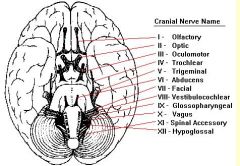
The olfactory nerve is actually a collection of sensory nerve rootlets that extend down from the olfactory bulb and pass through the many openings of the cribriform plate in the ethmoid bone.
|
|
|
|
CRANIAL NERVES CN-II
|
CN II. Optic Nerve
The optic nerve originates from the bipolar cells of the retina which are connected to the specialized receptors in the retina (rod and cone cells). |
|
|
|
CRANIAL NERVES CN-VII
|
CN VII. Facial Nerve
The facial nerve is mixed nerve containing both sensory and motor components. The nerve emanates from the brain stem at the ventral part of the pontomedullary junction. The nerve enters the internal auditory meatus where the sensory part of the nerve forms the geniculate ganglion. |
|
|
|
CRANIAL NERVES CN-VIII
|
CN VIII. Vestibulocochlear Nerve
The vestibulocochlear nerve is a sensory nerve that conducts two special senses: hearing (audition) and balance (vestibular). |
|
|
|
CRANIAL NERVES CN-X
|
CN X. Vagus Nerve.
The vagus nerve is the longest of the cranial nerve. Its name is derived from Latin meaning "wandering". True to its name the vagus nerve wanders from the brain stem through organs in the neck, thorax and abdomen. |
|
|
|
OCULAR MUSCLES
|
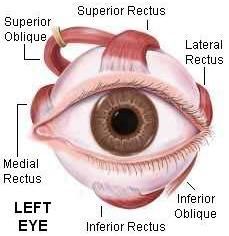
|
|
|
|
VAGUS
|
Vagus Nerve.
AUTONOMIC The vagus nerve is the longest of the cranial nerve. Its name is derived from Latin meaning "wandering". True to its name the vagus nerve wanders from the brain stem through organs in the neck, thorax and abdomen. The nerve exits the brain stem through rootlets in the medulla that are caudal to the rootlets for the ninth cranial nerve. The rootlets form the tenth cranial nerve and exit the cranium via the jugular foramen. Similar to the ninth cranial nerve there are two sensory ganglia associated with the vagus nerve. |
|
|
|
MENINGES
|
•Protects Cranial Nerves and Spinal Cord
The meninges are membranes that cover and protect the brain and spinal cord. The meninges consist of the pia mater, dura mater and the arachnoid. |
|
|
|
CRANIOSACRAL NS
|
???
|
|
|
|
THORACOLUMBAR
|
???
|
|
|
|
GLIAL CELLS
|
Glial cells are non-neural cells that perform "housekeeper" functions such as clearing out debris and excess materials. Glial cells support neurons by providing support and nutrition. There are several different types of glial cells: astrocytes, oligodendrocytes, microglia, ependymal cells, radial glial, satellite cells and schwann cells. It is estimated that there are 10 to 50 times more glial cells than there are neurons in the brain.
|
|
|
|
MYELIN
|
A substance rich in fatty lipids and proteins that covers and protects nerves. Myelin is a layered tissue that "sheathes" the nerve fibers. The myelin sheath aids in the rapid and efficient transmission of impulses along the nerve cells.
|
|
|
|
RECEPTORS
|
RECEPTORS-DETECTS STIMULI
Receptors transmit 4 kinds of info. 1) modality-type (vision) 2) location-receptive field 3) intensity-dim 4) duration length RECEPTORS classification modality 1) thermo-heat 2) photo-light 3)chemo - chemical 4)mechano-physical 5)noci-pain RECEPTORS classification origin stimulus a) extro- b) intero- c) proprio- RECEPTORS classification by RECEPTORS distribution a) general skin, muscle, tendon, joint capsule, viscera |
|
|
|
MODALITY
|
??????
|
|
|
|
NERVE ENDINGS
|
UNENCAPSULATED NERVE ENDINGS
A) free nerve endings 1) warm 2) cold 3) noci- b) tactile discs (merkel) strarum basale c) peritrichail |
|
|
|
NERVE ENDINGS
|
Encapsulated Nerve endings
a) tactile corpuscles (Meissner) tactile discrimination b) (krause) mechanoreceptor sound touch muscle contraction c) lamellar corpuscles (pacinian) presure, touch, viberation d) bulbous (ruffini) continuous presure e) muscle spindle mechanorecptor f) tendon organ (golgi) mechanorecptor |
|
|
|
Special Senses
|
Special Senses
|
|
|
|
Olfactory cells
|
olfactory cells a set of specialized cells of the mucous membranes of the nose, which are receptors of smell.
|
|
|
|
Olfactory tracts
|
Set of nerve fibers conducting impulses from olfactory receptors to the cerebral cortex. It includes the OLFACTORY NERVE; OLFACTORY BULB; olfactory tract, olfactory tubercle, anterior perforated substance, and olfactory cortex. The term rhinencephalon is restricted to structures in the CNS receiving fibers from the olfactory bulb.
|
|
|
|
GUSTATORY CELLS
|
??
|
|
|
|
GUSTATORY TRACTS
|
??
|
|
|
|
TASTE BUD
|
Taste buds are composed of groups of about 40 columnar epithelial cells bundled together along their long axes. Taste cells within a bud are arranged such that their tips form a small taste pore, and through this pore extend microvilli from the taste cells. The microvilli of the taste cells bear taste receptors and it appears that most taste buds contain cells that bear receptors for 2 or 3 of the basic tastes.
|
|
|
|
AUDITORY CELLS
|
????
|
|
|
|
AUDITORY TRACTS
|
a bundle of ascending fibres that originate from the cochlear and auditory relay nuclei of the rhombencephalon, enter the trapezoid body, a transverse fibre stratum in which about half their number decussate, and from here turn rostrally along the lateral side of the spinothalamic tract; in the midbrain, it arches dorsally and enters the inferior colliculus in which all of its fibres terminate; the auditory pathway is transsynaptically extended from here by the brachium of the inferior colliculus to the medial geniculate body of the thalamus, from which in turn the auditory radiation leads to the auditory cortex; intercalated in the trapezoid body and along the ascending trajectory of the lemniscus are several cell groups in which part of the fibres synapse.
|
|
|
|
AUDITORY OSSICLES
|
ossicles of the middle ear that transmit acoustic vibrations from the eardrum to the inner ear
bonelet, ossicle, ossiculum - a small bone; especially one in the middle ear malleus, hammer - the ossicle attached to the eardrum incus, anvil - the ossicle between the malleus and the stapes stapes, stirrup - the stirrup-shaped ossicle that transmits sound from the incus to the cochlea |
|
|
|
VESTIBULAR TRACTS
|
BALANCE
|
|
|
|
OCULAR ANATOMY
|
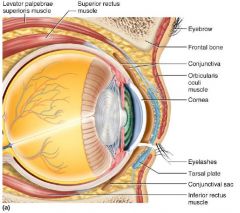
|
|
|
|
OCULAR ANATOMY
|

|
|
|
|
GLAUCOMA
|
The two main types of glaucoma are primary open angle glaucoma (POAG), and angle closure glaucoma. These are marked by an increase of intraocular pressure (IOP), or pressure inside the eye. When optic nerve damage has occurred despite a normal IOP, this is called normal tension glaucoma. Secondary glaucoma refers to any case in which another disease causes or contributes to increased eye pressure, resulting in optic nerve damage and vision loss.
|
|
|
|
LENS
|
concav = near sighted , thick
convex = far sighted, thin |
|
|
|
RODS/CONES
|
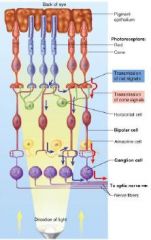
Only rods and cones produce visual images.
There are two types of photoreceptors in the human retina, rods and cones. Rods are responsible for vision at low light levels (scotopic vision). They do not mediate color vision, and have a low spatial acuity. Cones are active at higher light levels (photopic vision), are capable of color vision and are responsible for high spatial acuity. The central fovea is populated exclusively by cones. There are 3 types of cones which we will refer to as the short-wavelength sensitive cones, the middle-wavelength sensitive cones and the long-wavelength sensitive cones or S-cone, M-cones, and L-cones for short. |
|
|
|
CILIA DENDRITES
|
???
|
|
|
|
OPTIC TRACTS
|
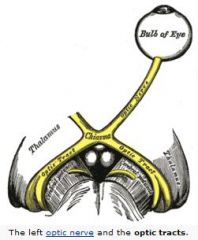
It is a continuation of the optic nerve and runs from the optic chiasm (where half of the information from each eye crosses sides, and half stays on the same side) to the lateral geniculate nucleus.
|
|
|
|
CN VIII TRACTS
|
?????
|
|
|
|
SOMATOSENSORY
|
sensory activity having its origin elsewhere than in the special sense organs (as eyes and ears) and conveying information about the state of the body proper and its immediate environment ; also : relating to or being either of two regions in the parietal lobe that receive and process somatosensory stimuli.
|
|
|
|
EAR ANATOMY
|
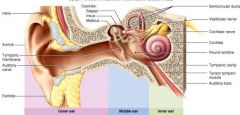
??
|
|
|
|
ENDOCRINE PROCESSES
|
The Endocrine System
Regulates long-term processes: Growth Development Reproduction Uses chemical messengers to relay information and instructions between cells. |
|
|
|
TYPES OF COMMUNICATION
|
Endocrine Communication
Endocrine cells release chemicals (hormones) into bloodstream Alters metabolic activities of many tissues and organs simultaneously. Target Cells Are specific cells that possess receptors needed to bind and “read” hormonal messages Hormones Stimulate synthesis of enzymes or structural proteins Increase or decrease rate of synthesis Turn existing enzyme or membrane channel “on” or “off” |
|
|
|
GROUPS OF HORMONES
|
Amino acid derivatives
Peptide hormones Lipid derivatives |
|
|
|
TYROSINE
|
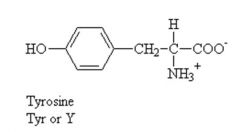
?
|
|
|
|
PITUITARY
|
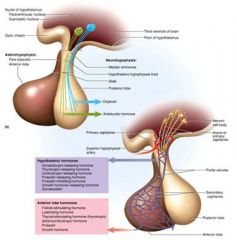
secretes hormones directly into the bloodstream. The term hypophysis (from the Greek, “lying under”) refers to the gland’s position on the underside of the brain. The pituitary has a major role in the regulation of many endocrine functions.
|
|
|
|
CYCLIC AMP
|
Activated when hormone binds to receptor at membrane surface and changes concentration of second messenger cyclic-AMP (cAMP) within cell:
increased cAMP level accelerates metabolic activity within cell!!! |
A cyclic nucleotide of adenosine that acts at the cellular level to regulate various metabolic processes and mediate the effects of many hormones.
|
|
|
G PROTIEN
|
Enzyme complex coupled to membrane receptor, involved in link between first messenger and second messenger
Binds GTP |
|
|
|
CALMODULIN
|

calcium-binding protein expressed in all eukaryotic cells. It can bind to and regulate a number of different protein targets, thereby affecting many different cellular functions
|
|
|
|
RELEASING FACTORS
|
any of several hormones produced in the hypothalamus and carried by a vein to the anterior pituitary gland where they stimulate the release of anterior pituitary hormones; each of these hormones causes the anterior pituitary to secrete a specific hormone
endocrine, hormone, internal secretion - the secretion of an endocrine gland that is transmitted by the blood to the tissue on which it has a specific effect |
|
|
|
NEGITIVE FEEDBACK
|
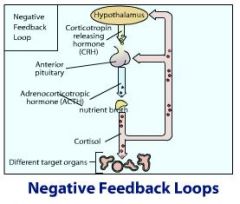
a hormone from a peripheral gland, for example, cortisol, binds to its receptor on cells in the hypothalamus and adenohypophysis, and has the effect of inhibiting secretion of tropic hormones
|
|
|
|
THYMUS
|
stimulate T lymphoctes
|
|
|
|
C CELLS
|
a cell type of the thyroid gland, situated between or within the walls of follicles, with numerous small membrane-limited secretory granules in the cytoplasm. The source of calcitonin. Called also parafollicular cell.
|
|
|
|
PTH
|
A chemical substance produced by the parathyroid glands. This hormone is a major element in regulating calcium in the body.
|
|
|
|
ADRENALS
|
The adrenal glands, which reside on top of the kidneys, are responsible for producing a myriad of hormones - aldosterone, cortisol, adrenaline, progesterone, estrogen, and testosterone. These hormones are vital for optimal body function; an imbalance of any of these hormones can cause dramatic health issues - anxiety, depression, fatigue, insomnia, infertility, unrefreshing sleep, hormone imbalances, excessive PMS symptoms, menopause, loss of libido, thyroid dysfunction, arthritis, and more!
|
|
|
|
TARGET CELL RESPONSE
|
??
|
|
|
|
ENDOCRINE REFLEXES
|
Endocrine reflexes are the counterparts of neural reflexes
|
|
|
|
HYPOTHALAMUS
|
•Controls Autonomic Functions
•Emotions •Endocrine Functions •Homeostasis •Motor Functions •Regulates Food and Water Intake •Regulates Sleep Wake Cycle The hypothalamus is located in the limbic system of the brain, an area of the brain that controls emotions and behavior. So it makes sense that the hypothalamus gland controls our emotions and behaviors, including sexual behavior. Another key activity of the hypothalamus is secreting hormones that support the normal function of the pituitary gland. Other fundamental tasks, performed by the hypothalamus, include regulating body temperature, appetite, digestion, circulation and sleep. Additionally, the hypothalamus gland controls critical metabolic activities, helping us maintain healthy fluid levels and properly metabolize fats and sugars. |
|
|
|
EXOCRINE PANCREAS
|
Control of the exocrine function of the pancreas is via the hormones gastrin, cholecystokinin and secretin, which are hormones secreted by cells in the stomach and duodenum, in response to distension and/or food and which cause secretion of pancreatic juices.
|
|
|
|
ENDOCRINE PANCREAS
|
endocrine gland producing several important hormones, including insulin, glucagon, and somatostatin, as well as an exocrine gland, secreting pancreatic juice containing digestive enzymes that pass to the small intestine. These enzymes help in the further breakdown of the carbohydrates, protein, and fat in the chyme.
|
|
|
|
CHOLESTEROL PRECURSOR
|
precursor for all hormones
|
|
|
|
T2/T3
|
tertosterone, estrogen produce FSH + LH gamies to produce.
|
|
|
|
NEUROHYPOSIS
|
ADH toxtiocine
|
|
|
|
GRAVES DISEASE
|
Hyperthyroidism
|
|
|
|
CALCIUM METTABOLISM
|
takes CA out of bone
|
|
|
|
EICOSANOID
|
Eicosanoid: A lipid mediator of inflammation derived from the 20-carbon atom arachidonic acid (20 in Greek is "eicosa") or a similar fatty acid. The eicosanoids include the prostaglandins, prostacyclin, thromboxane, and leukotrienes.
|
|

